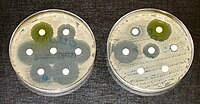
Photo from wikipedia
Due to the increased resistance to all available antibiotics and the lack of vaccines, Neisseria gonorrhoeae (the gonococcus) poses an urgent threat. Although the mechanisms of virulence and antibiotic resistance… Click to show full abstract
Due to the increased resistance to all available antibiotics and the lack of vaccines, Neisseria gonorrhoeae (the gonococcus) poses an urgent threat. Although the mechanisms of virulence and antibiotic resistance have been largely investigated in this bacterium, very few studies have addressed the stringent response (SR) that in pathogenic bacteria controls the expression of genes involved in host-pathogen interaction and tolerance and persistence toward antibiotics. In this study, the results of the transcriptome analysis of a clinical isolate of N. gonorrhoeae, after induction of the SR by serine hydroxamate, provided us with an accurate list of genes that are transcriptionally modulated during the SR. The list includes genes associated with metabolism, cellular machine functions, host-pathogen interaction, genome plasticity, and antibiotic tolerance and persistence. Moreover, we found that the artificial induction of the SR in N. gonorrhoeae by serine hydroxamate is prevented by thiostrepton, a thiopeptide antibiotic that is known to interact with ribosomal protein L11, thereby inhibiting functions of EF-Tu and EF-G, and binding of pppGpp synthase I (RelA) to ribosome upon entry of uncharged tRNA. We found that N. gonorrhoeae is highly sensitive to thiostrepton under in vitro conditions, and that thiostrepton, in contrast to other antibiotics, does not induce tolerance or persistence. Finally, we observed that thiostrepton attenuated the expression of key genes involved in the host-pathogen interaction. These properties make thiostrepton a good drug candidate for dampening bacterial virulence and preventing antibiotic tolerance and persistence. The ongoing challenge is to increase the bioavailability of thiostrepton through the use of chemistry and nanotechnology.
Journal Title: Frontiers in Microbiology
Year Published: 2023
Link to full text (if available)
Share on Social Media: Sign Up to like & get
recommendations!